Venus and Jupiter cross paths at dawn

So , here we are at last! It took several weeks to prepare for this celestial summit, finding an available site in a beautiful constellation—Gemini—moving the Sun further away, and relocating the two brightest planets in the sky. But on August 12, at the dawn of dawn, Venus and Jupiter will be waiting for us above the east-northeast horizon, shining brightly just 0.9 degrees apart—nearly the same apparent distance as in the opening image of this post. That's less than twice the apparent diameter of the Full Moon, and you can hide this "double planet" with the tip of your outstretched little finger. It's an apparent rapprochement, of course, since Venus and Jupiter, while they are in virtually the same position in the sky, are not at all the same distance from us: Venus is 185 million kilometers away and Jupiter is 890 million kilometers.
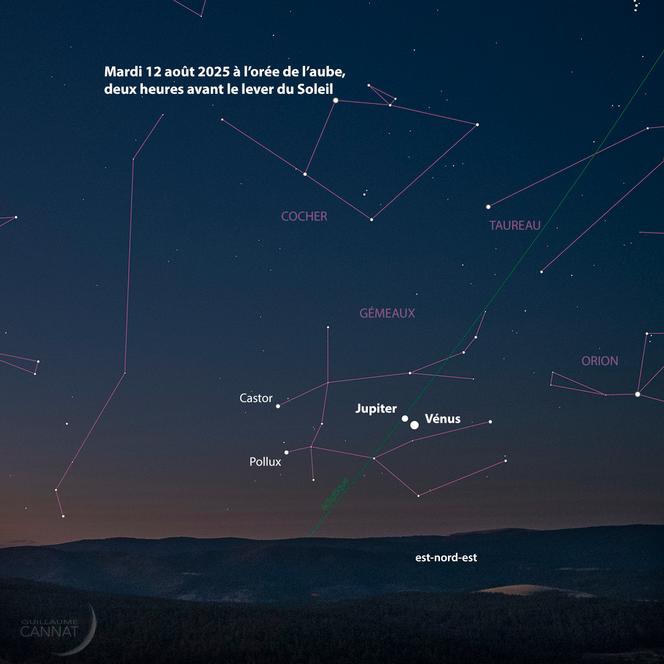
This ephemeral planetary pair rises nearly three hours before the Sun and, at the beginning of dawn, more than an hour and a half before the Sun's arrival, it is easily spotted with the naked eye at more than ten degrees above the east-northeast horizon, more than the height of your fist with your arm outstretched. You can observe this conjunction both in the city and in the countryside and any light pollution at your observation site should not bother you, as it will quickly be erased by the increasing clarity of dawn. If your sky is clear, you can even try to spot the intense brightness of these two planets with the naked eye and binoculars in the blue sky after sunrise, taking care never to look at it naturally!
Venus is currently six times brighter than Jupiter—their difference in brightness is perfectly perceptible to the naked eye—and its brightness is as pure and white as that of its neighbor. If you observe this conjunction with binoculars or photograph it with a telephoto lens, two of the four Galilean moons, Ganymede and Callisto, will be clearly visible, quite far from Jupiter's disk, while Io and Europa will be more difficult to distinguish against the planet. The waning gibbous Moon will be present on the southern side of the sky during this observation and should illuminate your immediate surroundings enough to give it depth and contribute to the beauty of this celestial landscape just before the arrival of day.
Also read
Every month, I invite you to discover my images of the sky in my Sky Guide Letter .
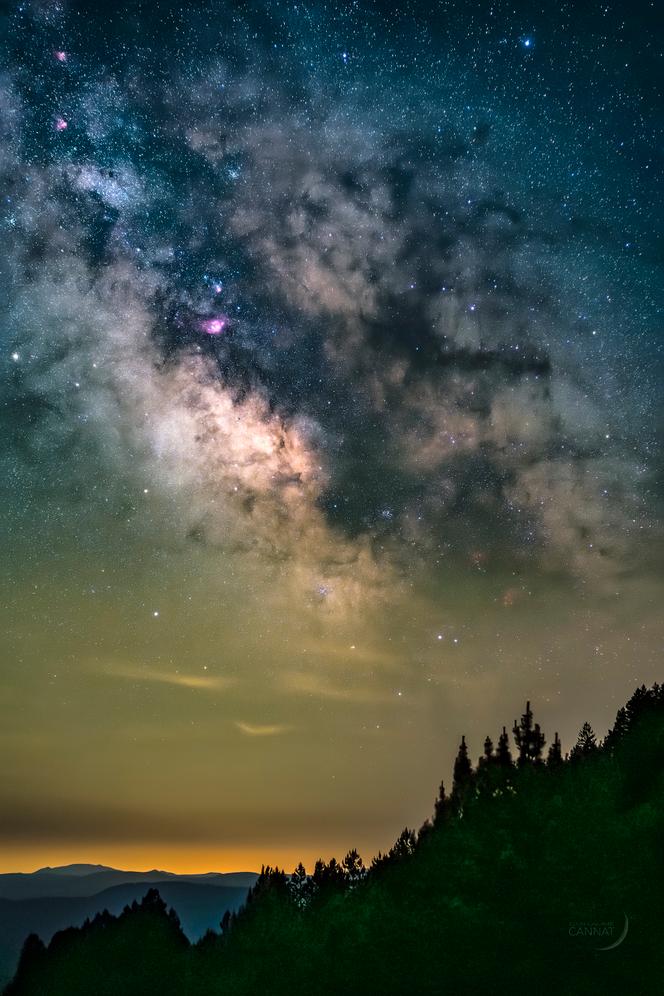
Moon Phases in August
The Moon is in first quarter on the 1st in Libra, full on the 9th in Capricorn, last quarter on the 16th in Aries, new on the 23rd in Leo and again in first quarter on the 31st in Scorpio.
A few meetings under the August sky
From Friday, August 1st to Sunday, August 3rd, the 35th edition of the Nuits des étoiles will take place throughout France (and beyond). Organized since 1991 by the French Astronomy Association, with the help of hundreds of clubs, associations, local authorities and volunteer amateur and professional astronomers, the Nuits des étoiles offers more than 550 events (observation evenings, exhibitions, conferences, practical workshops, courses, hikes under the stars, planetarium sessions, etc.) to discover astronomy and the beauty of the summer sky. These events are free, but you sometimes have to book your place, so I invite you to consult the website which lists them to find out more . A few shooting stars will probably be visible during the Nuits des étoiles, but the maximum activity of the Perseid shower will occur on August 12th and 13th in the presence of a dazzling gibbous Moon.
From Monday, August 11th to Wednesday, August 13th, you can spend your nights with Saturn and the shooting stars of the Perseid meteor shower, but the powerful brightness of the waning gibbous Moon will prevent you from distinguishing the fainter meteor arrows. Our satellite will rise in the east not far from Saturn before the end of astronomical twilight, less than two hours after sunset. At that time, the constellation of Perseus will be just above the north-northeast horizon, and you can already watch for shooting stars around it—use the sky map available a little further down in this post. By the end of the night, just before the first light of dawn arrives, Saturn and the Moon will be more than forty degrees above the meridian, and Perseus will be about fifty degrees above the east.
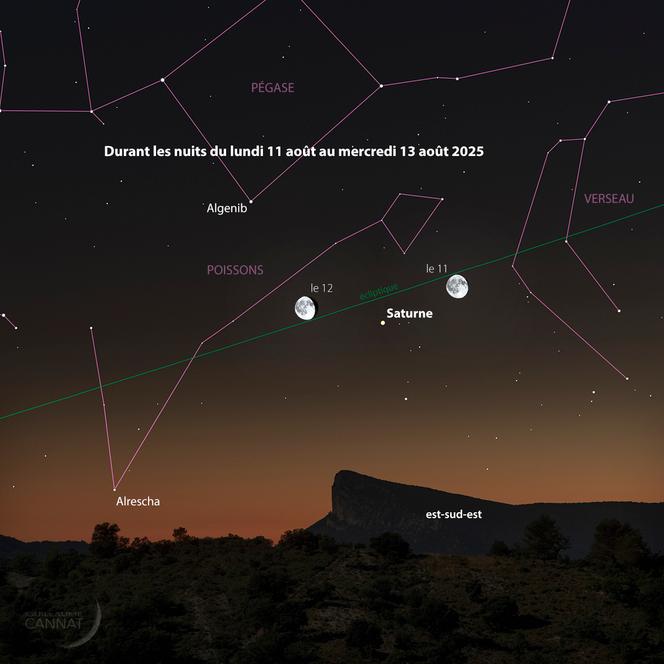
At dawn on Wednesday, August 20, a week after their close conjunction, Venus and Jupiter will already be eight degrees apart, and the old Moon will come to greet them. Nearly an hour and a half before sunrise, its magnificent crescent, enlarged by the ashen light, will draw a large equilateral triangle with these two planets. The three stars will shine more than fifteen degrees above the east-northeast horizon, or the height of your fist with your thumb raised and arm outstretched as if you were hitchhiking. Notice the fainter brightness of the stars Castor and Pollux in Gemini to the left of the Moon, and, close to the horizon, watch for the rise of the planet Mercury. It has been visible a good hour before sunrise since mid-August, and the slow increase in its brightness now allows it to be spotted with the naked eye, unless the horizon is too hazy. The apparent Mercury-Venus-Jupiter alignment, visible for a few mornings, almost materializes the plane of the Solar System in the dawn sky.
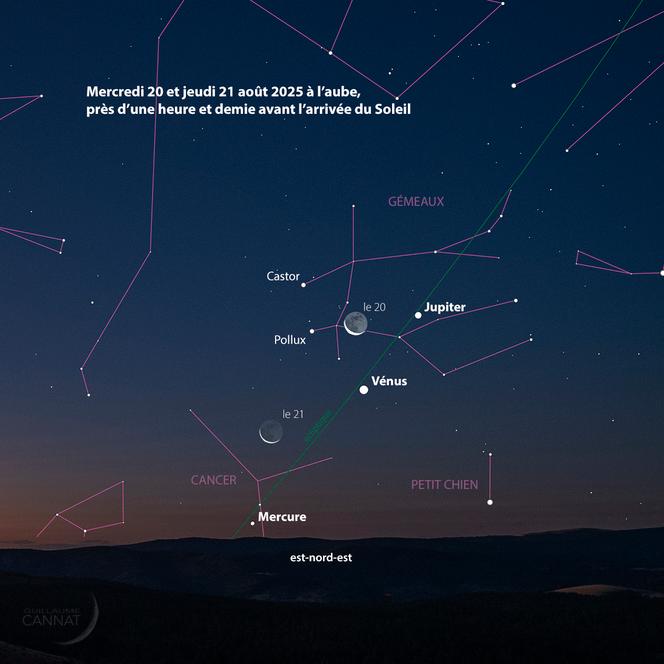
The sky in August
At the end of August twilight, nearly two hours after sunset, the Milky Way slices the celestial vault into two practically equal portions from north-northeast to south-southwest. We do not have the chance to admire the brightest and densest region of the Milky Way at its zenith as can observers in the tropics. However, the fact that Sagittarius and therefore the galactic heart are close to the southern horizon allows us to turn our backs on it and look away, towards the outside of the flattened disk in which the Sun and its planetary retinue circulate. Since our star is located closer to the edge than to the center of this disk, the Milky Way that we discover in this direction is much less crowded. Lying down under a beautiful sky crossed by the Milky Way, with your head to the south, and scanning it with your eyes, the impression of moving away from your heart at high speed is striking. You must obviously settle down under a moonless sky properly protected from light pollution and let your eyes adjust to the darkness for at least twenty minutes so that the more sensitive night vision can develop sufficiently. Use a low-intensity lamp colored red or orange to move around. If you spend the whole night under the stars, you will have the great joy of seeing the constellations that will brighten our winter evenings appear before dawn: Taurus, Auriga, Gemini and even Orion. At the end of August, spot the incandescent glow of Sirius close to the east-southeast horizon, an hour before daybreak.
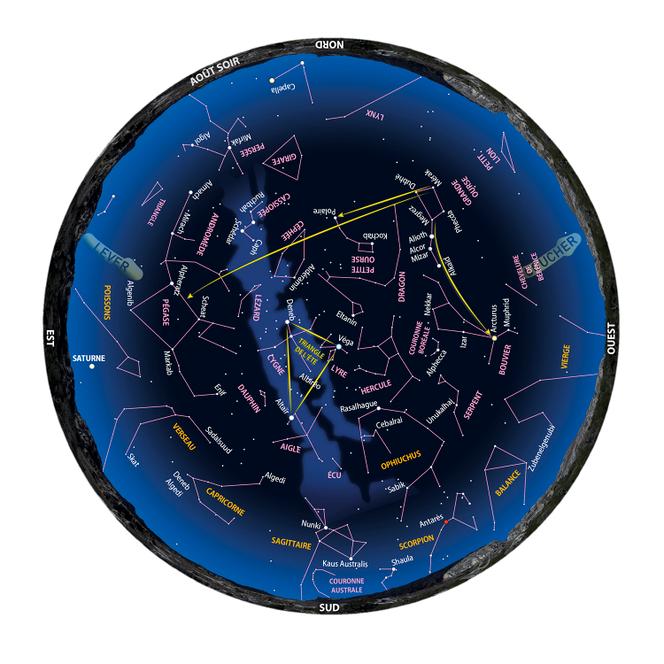
Map of the sky visible in August 2025 towards the end of twilight at the latitude of metropolitan France. The maps in this post can be used in Europe and around the world within a band extending from 38° to 52° north latitude. If you are further than 45° north, the North Star will be higher in your sky and, in the evening, Altair in the Eagle will be that much closer to the southern horizon. If you are less than 45° north, the North Star will be closer to the northern horizon and Altair will be further from the southern horizon.
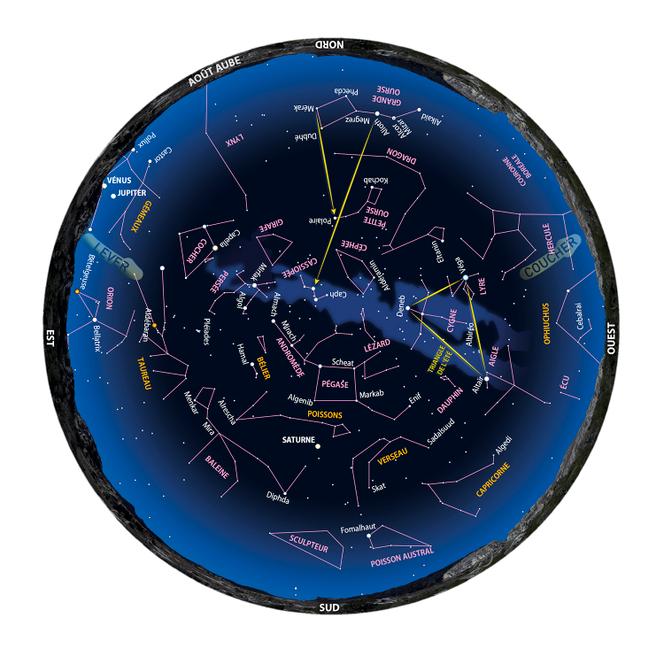
This map shows the sky visible in August 2025 at the dawn of dawn at the latitude of metropolitan France. Be careful, the sky maps are not upside down! They simply represent the stars located above our heads. If you were to lie down with your head facing north and your feet facing south, east would be to your left and west to your right. Use these maps by printing them and rotating them so that the name of the direction in which you are observing is written right side up. The constellations and stars that you will find in the portion of the sky facing you are all those whose names are legible without tilting your head too much. The names of the constellations and their main stars are indicated, as well as the outline of the most important constellations; this outline is sometimes incomplete when the figure is partly hidden below the horizon. The sky is very vast and the constellations that appear small on maps are, in fact, very large: your open hand and outstretched arm barely hide the entire Chariot of the Big Dipper.
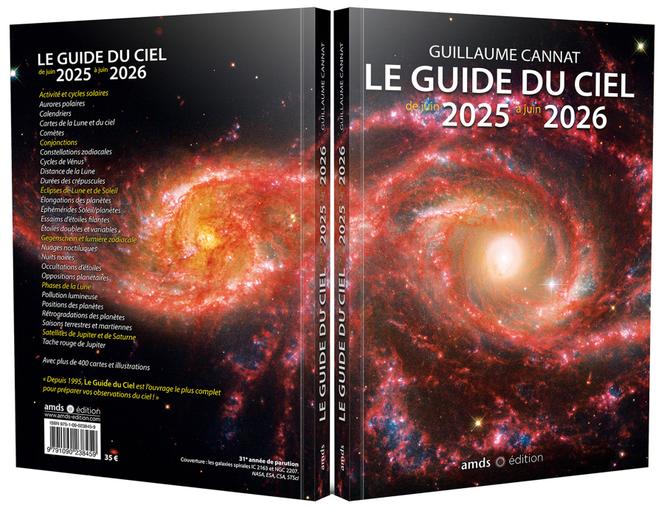
The 31st edition of my annual Sky Guide is available at your local bookstore.
Contribute
Reuse this contentLe Monde




